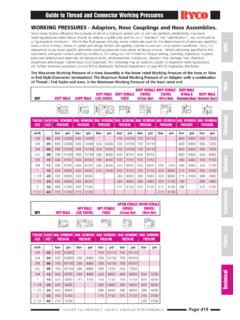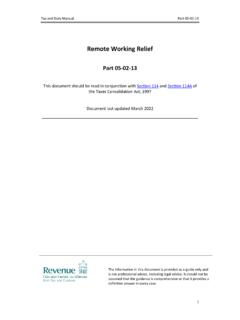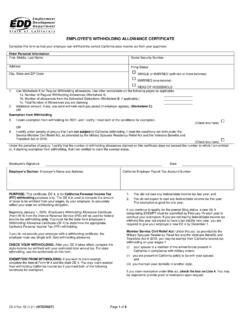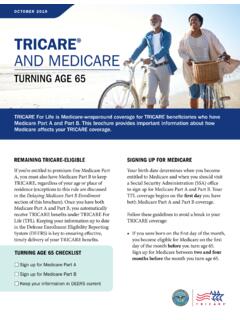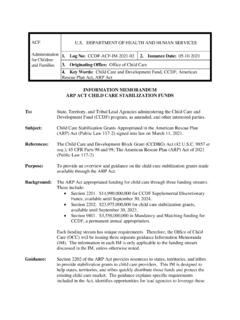Transcription of Taxable Fringe Benefit Guide - IRS tax forms
1 Taxable Fringe Benefit Guide FEDERAL, STATE, AND LOCAL GOVERNMENTS THE INTERNAL REVENUE SERVICE January 2012 TABLE OF CONTENTS 1 Introduction 2 How To Report Taxable Fringe benefits 3 Working Condition Fringe benefits 4 De Minimis Fringe benefits 5 No-Additional-Cost Fringe benefits 6 Qualified Employee Discount 7 Qualified Transportation Fringe benefits (QTF) 8 Health and Medical benefits 9 Travel Expenses 10 Transportation Expenses 11 Moving Expenses 12 Meals and Lodging 13 Use of Employee-Owned Vehicle 14 Employer-Provided Vehicle 15 Equipment and Allowances 16 Awards and Prizes 17 Professional Licenses and Dues 18 Educational Reimbursements and Allowances 19 Dependent Care Assistance 20 Group-Term Life Insurance 3 4 21 Volunteers 22 Independent Contractors Appendix: Contact Information INDEX 1 Introduction The Taxable Fringe benefits Guide was created by the Internal Revenue Service office of Federal, State and Local Governments (FSLG) to provide governmental entities with a basic understanding of the Federal tax rules relating to employee Fringe benefits and reporting.
2 As a supplement to other IRS publications, the Taxable Fringe Benefit Guide is designed to help individuals responsible for determining the correct tax treatment of employee Fringe benefits and the appropriate withholding and reporting for them. This publication covers: How to determine whether specific types of benefits or compensation are Taxable . General procedures for computing the Taxable value of Fringe benefits . Reporting the Taxable value of benefits on forms W-2 and 1099-MISC. Rules for withholding Federal income tax, social security and Medicare taxes from Taxable Fringe benefits . How to contact the Internal Revenue Service with questions regarding taxation and reporting requirements. NOTICE This Guide is intended to provide basic information on the tax treatment of Fringe benefits . It reflects the interpretation by the IRS of tax laws, regulations, and court decisions. The explanations in the Guide are intended for general guidance only, and are not intended to provide a specific legal determination with respect to a particular set of circumstances.
3 Additional research may be required before a determination may be made on a particular issue. Citations to legal authority are included in the text. You may contact the IRS for additional information. You may also want to consult a tax advisor to address your situation. 5 What Is a Fringe Benefit ? A Fringe Benefit is a form of pay (including property, services, cash or cash equivalent) in addition to stated pay for the performance of services. Some forms of additional compensation are specifically designated as Fringe benefits in the Internal Revenue Code; others, such as moving expenses or awards, have statutory provisions providing for special tax treatment but are not designated as Fringe benefits by the Code. This publication uses the term broadly to refer to all remuneration other than stated pay for which special tax treatment is available. The definition of Fringe benefits applies to services of employees and independent contractors; however, unless otherwise indicated, this Guide applies to Fringe benefits provided by an employer to an employee.
4 (For a discussion of whether a worker is an employee or independent contractor, see Publication 15-A.) Fringe benefits for employees are Taxable wages unless specifically excluded by a section of the Internal Revenue Code (IRC). IRC 61 IRC 3121, 3401; IRC 61(a)(1) The IRC may provide that Fringe benefits are nontaxable, partially Taxable , or tax-deferred. These terms are defined below. Taxable Includible in gross income unless excluded under an IRC section. Taxable means the Benefit is included in the employees' wages and reported on form W-2, Wage and Tax Statement, and generally is subject to Federal income tax withholding, social security (unless the employee has already reached the current year social security wage base limit), and Medicare. If the recipient is an employee, this amount is includible as wages. For example, bonuses are always Taxable because no IRC section excludes them from taxation. Nontaxable (excludable) Excluded from wages by a specific IRC section; for example, qualified health plan benefits excludable under section 105.
5 Partially Taxable - Part is excluded by IRC section and part is Taxable . benefits may be excludable up to dollar limits, such as the public transportation subsidy under IRC 132. Tax-deferred Benefit is not Taxable when received, but subject to tax later. For example, employer contributions to an employee's pension plan may not be Taxable when made, but may be taxed when distributed to the employee. More than one IRC section may apply to the same Benefit . For example, education expenses up to $5,250 may be excluded from tax under IRC 127. Amounts exceeding $5,250 may be excluded from tax under IRC 132. A Benefit provided on behalf of an employee is Taxable to an employee even if the Benefit is received by someone other than the employee, such as a spouse or a child. Reg. (a)(4) If an employee's wages are not normally subject to social security or Medicare taxes (for example, because the employee is covered by a qualifying public retirement system), otherwise Taxable Fringe benefits are not be subject to social security or Medicare taxes.
6 6 7 General Valuation Rule Generally, Taxable Fringe benefits are valued at their fair market value (FMV). FMV is the amount a willing buyer would pay an unrelated willing seller, neither one forced to conduct the transaction and both having reasonable knowledge of the facts. In many cases, the cost and FMV are the same; however, there are many situations in which FMV and cost differ, such as when the employer incurs a cost less than the value to provide the Benefit . Reg. (b) The Taxable amount of a Benefit is reduced by any amount paid by or for the employee. For example, an employee has a Taxable Fringe Benefit with a fair market value of $ per day. If the employee pays $ per day for the Benefit , the Taxable Fringe Benefit is $ per day. Special valuation rules apply for certain Fringe benefits and will be covered in other sections.
7 IRC Sections Excluding Fringe benefits The following Code sections provide a statutory basis for specific benefits . They are discussed later in the text. 104 Compensation by employer for injury or sickness 105 benefits received through employer health or accident insurance 106 Health insurance premiums paid by employer 117(d) - Qualified tuition reductions 119 - Meals or lodging for employer's convenience 125 - Cafeteria plans 127 - Educational assistance program 129 - Dependent care assistance program 132(b) - No additional-cost service 132(c) - Qualified employee discounts 132(d) - Working condition Fringe benefits 132(e) - De minimis Benefit 132(f) - Qualified transportation expenses 132(g) - Qualified moving expense reimbursements 132(j) - On-premises athletic facilities 132(m) - Qualified planning services 132(n) Qualified military base realignment and closure Fringe 137 Adoption assistance programs 2 How To Report Taxable Fringe benefits In general, Taxable Fringe benefits are reported as wages on form W-2 for the year in which the employee received them.
8 However, there are many special rules and elections for different benefits . IRC 451(a); IRS Ann. 85-113, 1985-31 Employer s Election of When To Withhold The employer may elect to treat Taxable Fringe benefits as paid in a pay period, quarterly, semiannual, or annual basis, but no less frequently than annually. IRS Ann. 85-113 Alternative Rule for Income Tax Withholding The employer may elect to add Taxable Fringe benefits to employee regular wages and withhold on the total, or may withhold on the Benefit at the supplemental wage rate of 25%. Reg. (g)-1; Reg. (a)-1T Special Accounting Period Under a special rule, benefits provided in November and December, or a shorter period in the last 2 months of the year, may be treated as paid in the following year. Only the value of benefits actually provided during the last 2 months may be treated as paid in the subsequent year.
9 You do not have to notify the IRS that you are using this special accounting rule. IRS Ann. 85-113 An employer may use this rule for some Fringe benefits and not others. The special accounting period need not be the same for each Fringe Benefit . However, if an employer uses the special accounting period rule for a particular Benefit , the rule must be used for that Benefit for all employees who receive it. Employer s Election Not To Withhold Income Tax on Vehicle Use An employer may elect not to withhold income taxes on the Taxable use of an employer's vehicle that is includible in wages if the employer: (1) notifies the employee, and (2) includes the Benefit in the employee s wages on the form W-2 and withholds social security and Medicare tax. IRC 3402(s)(1) Note: This election is available for employer-provided vehicles only. In general, an employer does not have a choice whether to withhold on Taxable Fringe benefits .
10 Accountable Plan An accountable plan is an allowance or reimbursement policy (not necessarily a written plan) under which amounts are nontaxable to the recipient if the following requirements are met: 8 There must be a business connection to the expenditure. There must be adequate accounting by the recipient within a reasonable period of time. Excess reimbursements or advances must be returned within a reasonable period of time. IRC 62(c); Reg. Business Connection Business connection means that the expense must be a deductible business expense incurred in connection with services performed as an employee. If not reimbursed by the employer, the expense would qualify as a deductible expense by the employee on the employee s 1040 income tax return. Reg. (d) Adequate Accounting The employee must verify the date, time, place, amount, and business purpose of expenses.










